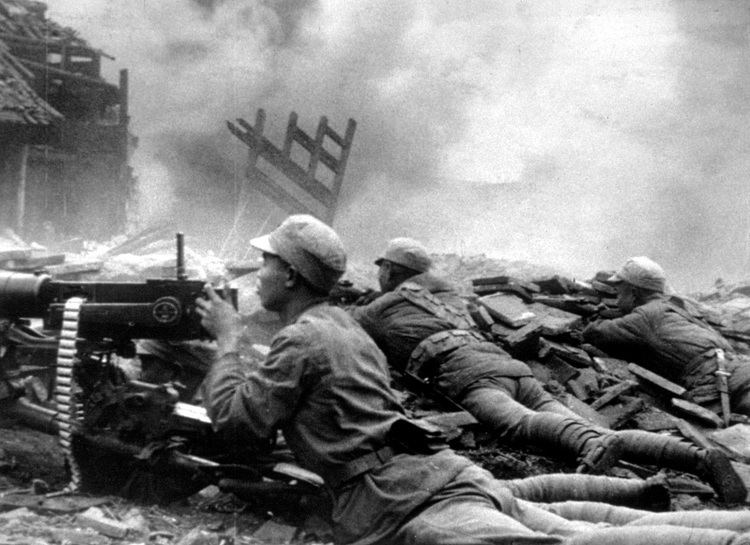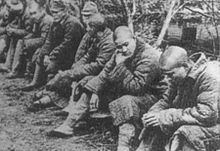~210,000 61,000 | Dates 2 Nov 1943 – 20 Dec 1943 | |
 | ||
20,000 More than 11,000 dead and wounded (according to the diary record from Shunroku Hata who is the field marshal of Imperial Japanese Army) Results Chinese victory, Japanese capture the city, but later withdraw in January 1944 Similar Second Sino‑Japanese War, Battle of Wuhan, Battle of Changsha, Battle of West Hunan, Battle of Shanggao | ||
The battle of changde chinese troops drive japs from changteh changde newsreel footage
The Battle of Changde (Battle of Changteh; simplified Chinese: 常德会战; traditional Chinese: 常德會戰; pinyin: Chángdé Huìzhàn) was a major engagement in the Second Sino-Japanese War in and around the Chinese city of Changde (Changteh) in the province of Hunan. During the battle, Japan extensively used chemical weapons.
Contents
- The battle of changde chinese troops drive japs from changteh changde newsreel footage
- Battle of changde 1943 clip from death and glory in changde 2010
- Battle
- References

The purpose of the Japanese offensive was not to hold the city, but to maintain pressure on the Chinese National Revolutionary Army "in order to destroy their main units, to deny them the time needed for recuperation, regrouping, and retraining, and to make sure that no Chinese troops could be spared for the Burma front."

The Japanese were initially successful in their offensive operation, successfully capturing the city of Changde and causing terror among its civilians. However, they were pinned down in the city by a single Chinese division for long enough for other Chinese units to surround them with a counter-encirclement. Heavy casualties and the loss of their supply lines then forced the Japanese to withdraw, returning territorial control to the original status quo.
Some contemporary Western newspapers depicted the battle as a Chinese victory. American government film footage shows victorious Chinese troops with Japanese prisoners and captured Japanese flags and equipment on display after the battle. In addition, an American newsreel titled "Chinese troops drive Japs from Changteh" showed Chinese troops firing, with dead and captured Japanese on display.

Battle of changde 1943 clip from death and glory in changde 2010
Battle

On 2 November 1943, Isamu Yokoyama, commander of the Imperial Japanese 11th Army, deployed the 39th, 58th, 13th, 3rd, 116th and 68th divisions, a grand total of around 60,000 troops, to attack Changde from the north and the east. The Changde region was protected by the Chinese 6th War Area's 10th, 26th, 29th and 33rd Army Groups, as well as a river defense force and two other corps, for a grand total of 14 corps.
On 14 November, the Japanese 13th Division, with aid from collaborators, drove south and broke through the Chinese 10th and 29th Group Armies' defensive lines. On 16 November, Japanese paratroopers landed on Taoyuan, a county in the Changde region. At the same time, the Japanese 3rd and 116th Divisions attacked Changde. The city was guarded by the Chinese 74th Corps' 57th Division, whose commander, Yu Chengwan, led his single division of 8,000 soldiers to fight against the two invading Japanese divisions. Despite overwhelming numerical inferiority, the Chinese stubbornly held onto the city. 11 days and nights of fierce fighting saw heavy casualties on both sides. When Chinese reinforcements finally arrived, the remaining 100 survivors of the 57th Division, all of whom were wounded, escaped the city. On 6 December, the Japanese had captured Changde.
While the Chinese 57th Division pinned down the Japanese in the city, the rest of the 74th Corps, as well as the 18th, 73rd, 79th, and 100th Corps, and the 9th War Area's 10th Corps, 99th Corps and Jiangxi's 58th Corps arrived at the battlefield, forming a counter-encirclement on the Japanese forces.
Fang Xianjue's 10th corps was first to strike, successfully retaking Deshan on 29 November, before attacking the Japanese positions at Changde from the south. Unable to withstand the fierce Chinese assault, the Japanese utilized chemical weapons. The battle lasted for 6 days and nights, during which the Chinese 10th Division's commander Lieutenant General Sun Minjin was shot 5 times in the body and killed in action.
At this time, the other Chinese units were also pressing onto the Japanese positions. On 11 December, the Chinese broke through the Japanese lines and into the city, whereupon intense house-to-house fighting occurred. The Chinese then proceeded to intercept the Japanese army's supply lines. Depleted of food and ammunition, the Japanese retreated on 13 December.
The Chinese then pursued the retreating Japanese for more than 20 days. By 5 January 1944, the Japanese forces had withdrawn to their original positions prior to the offensive.
During this campaign, apart from the 10th Division's Sun Minjin, two other Chinese division commanders were killed. One was the 44th Corps' 150th Division's Lieutenant General Xu Guozhang, while the other one was the 73rd corps' 5th division's Lieutenant General Peng Shiliang. Xu was killed at Taifushan in Changde's northwest, aged 37. Peng was killed at the Taoyuan-Shimen line, aged 38.
The Changde campaign had the largest participation of the Chinese air force since the Battle of Wuhan.
Reporter Israel Epstein witnessed and reported on the battle. Witold Urbanowicz, a Polish fighter ace engaged in air combat over China in 1943, saw the city just after the battle. According to Urbanowicz, nearly 300,000 civilians died during the fighting in Changde.
The 2010 Chinese war film Death and Glory in Changde is based on the events in this battle.
